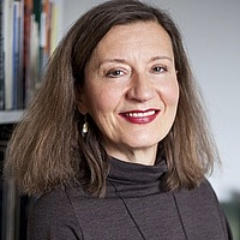 Ewa Lajer-Burcharth, William Dorr Boardman Professor of Fine Arts, is an art historian who focuses on 18th- and 19th-century European and contemporary post-1970s art. Lajer-Burcharth uses physical objects – such as paintings, sculptures, and textile arts – to enable more immersive forms of learning that enable students to experience objects of study in a hands-on way that is not possible with text-heavy teaching methods. These objects serve as a primary teaching tool for encouraging new perspectives and interrogating original sources. Students examine various objects from museum and library collections under the expert guidance of curators, and eventually assist in the curation of an exhibit. This allows students to have hands-on experience in both understanding and creating, rather than be solely trapped by reading and speaking. While her courses use physical objects as a point of reference, similar opportunities exist in other classroom contexts where students can contextualize the motivations of authors, musicians, and inventors, for example.
Ewa Lajer-Burcharth, William Dorr Boardman Professor of Fine Arts, is an art historian who focuses on 18th- and 19th-century European and contemporary post-1970s art. Lajer-Burcharth uses physical objects – such as paintings, sculptures, and textile arts – to enable more immersive forms of learning that enable students to experience objects of study in a hands-on way that is not possible with text-heavy teaching methods. These objects serve as a primary teaching tool for encouraging new perspectives and interrogating original sources. Students examine various objects from museum and library collections under the expert guidance of curators, and eventually assist in the curation of an exhibit. This allows students to have hands-on experience in both understanding and creating, rather than be solely trapped by reading and speaking. While her courses use physical objects as a point of reference, similar opportunities exist in other classroom contexts where students can contextualize the motivations of authors, musicians, and inventors, for example.
Hands-On Learning Through Objects
The benefits
Ewa’s students – in courses such as Modern Art and Modernity – “train in attentive looking” and develop an appreciation for what it takes to make something. Through this careful observation they can formulate stories based on details like the artist’s technique or use of materials; evidence they can use to practice making historically grounded arguments about the object in relation to the people and environment from which it originated, or even why it was created. When they are asked to co-curate an exhibit, students have to carefully consider the evidence through a variety of voices to support a specific argument about which objects help the chosen theme.
“You come [to class] with a set of ideas, but also with an open mind. Then you immerse yourself in research on objects, such that these objects can speak back to you and make you expand, extend, and go beyond whatever you have originally planned.”
The challenges
It takes time and patience to engage with physical objects. Curators suggest that students spend at least three hours with a single object to describe it effectively. While this can be challenging for students (especially impatient ones), less can be more as it fosters a deeper sense of appreciation and recognition of subtlety. Lajer-Burcharth provided the example of the portrait of Madame de Pompadour—when you get up close and spend time with it, you start to notice changes in the material that start to tell a story about what happened to the painting over the course of its life like adjustments made to its shape to fit various environments. This demonstrates that the opportunity that this time and patience provides to think through arguments is essential for student engagement. Curatorial parts of the courses also force students to wrestle with what to include versus what not to include, just as students writing essays must decide what arguments to address versus not.
Takeaways and best practices
-
Connect with the experts.
Lajer-Burcharth has worked with Harvard Art Museums, Peabody Museum of Archaeology & Ethnology, and Houghton Library frequently. The curatorial teams understand the historical context of the objects and are eager to help faculty develop programming for their courses. -
Push students to demonstrate cumulative knowledge.
It’s important to incorporate a summative experience for students to demonstrate their learning, such as curating an exhibition of their own or conducting a research project. This would move beyond the theoretical and provide students an opportunity to interact with content on a deeper level. It also asks them to take on a more active, curatorial role, selecting specific objects and arguing for their inclusion or exclusion from a particular theme of study. -
Integrate the outside of class experiences with classroom content.
Museum visits are most effective when they do not stand alone in the curriculum. Instructors should work to ensure that the visit complements the course materials, so that students can see how it builds on their learning, especially when the course subject may seem distant from art.
Bottom line
Objects have their own language and tell stories through their materiality and historical context. This requires a careful and attentive study that goes beyond merely observing the object's physical appearance. Requiring students to curate an exhibit allows them to interact with objects directly and gain practical experience in synthesizing key arguments around a particular question or theme.
